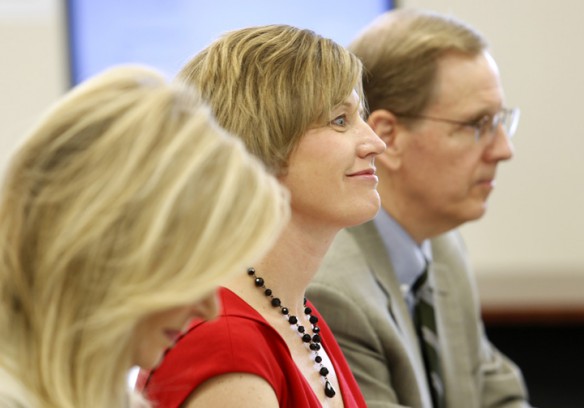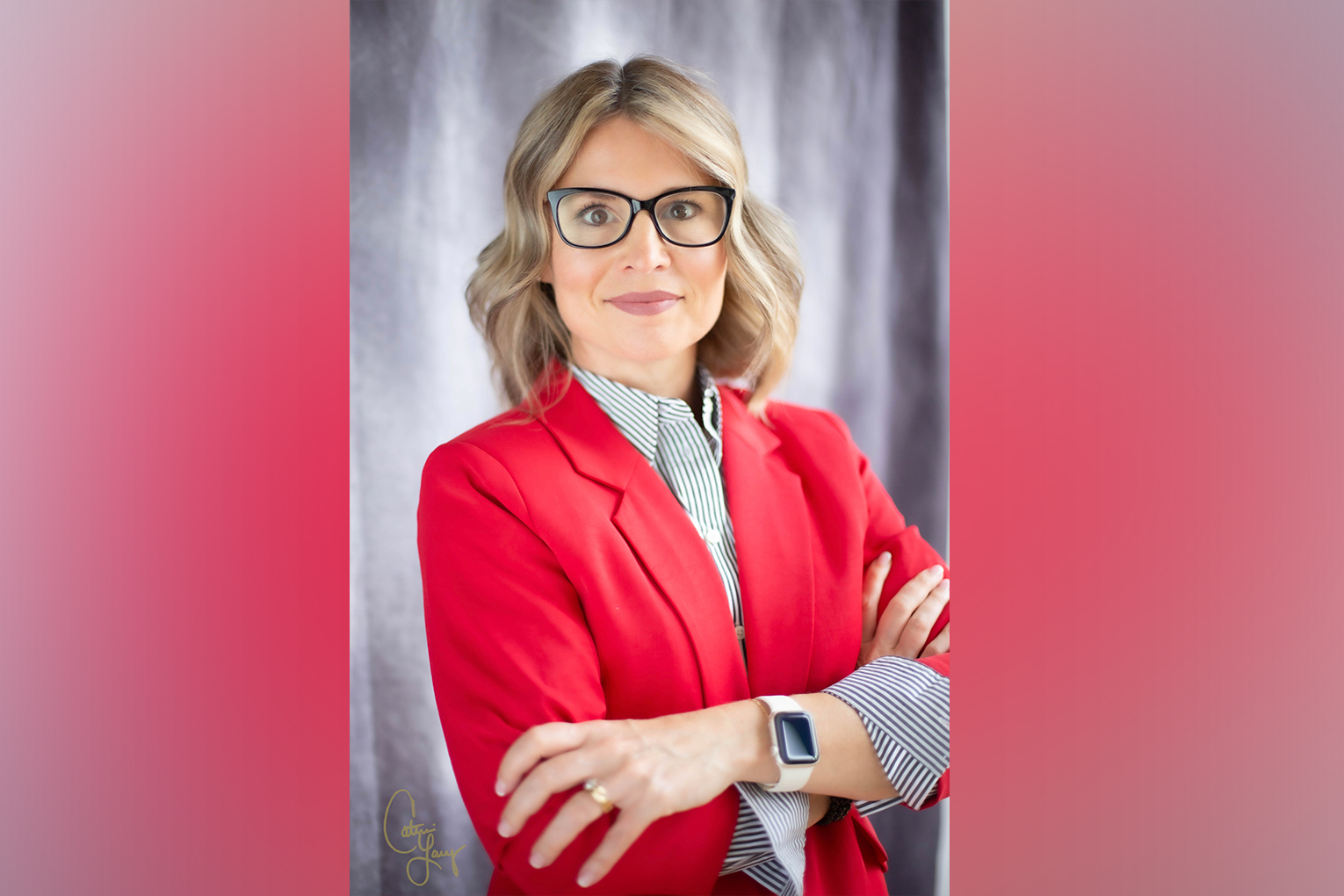
Associate Commissioner Amanda Ellis presents to the Kentucky Board of Education.
Photo by Amy Wallot, June 4, 2014
By Brenna R. Kelly
Brenna.kelly@education.ky.gov
Amanda Ellis became the Associate Commissioner of the Office of Next-Generation Learners at the Kentucky Department of Education (KDE) on June 1. Ellis came to the department in December 2013 after more than eight years as principal at Emma B. Ward Elementary (Anderson County).
She started her career as a middle school science teacher in Indiana after graduating from Indiana University. She also has taught at Anderson County Middle School and was a curriculum resource teacher. During her time at Emma B. Ward, Ellis was on the steering committee for the Professional Growth and Effectiveness System (PGES). Her school also participated in field tests and a pilot program for the system.
As associate commissioner, Ellis will help implement PGES in all 173 districts for the 2014-2105 school year. The new system will be without consequences the first year, then in 2015-2016 the systems will be implement statewide with consequences for accountability.
Ellis lives in Lawrenceburg with her husband, a teacher at Anderson County High School, and her two children.
How did piloting PGES as an elementary school principal prepare you to lead the statewide implementation?
It was a learning experience for me as a person and as a professional, but I saw immediately how it enhanced my role as a principal to coach teachers. I had a tool to really coach teachers to the next step no matter where they were.
It also really helped me to identify biases I had as an observer that I never knew that I that I had. And so learning the process and how to manage the time and reprioritize what’s really important helped me to share those experiences with other schools, which may not have started this journey.
You’ve called teaching not just a profession, but a lifestyle. What do you mean by that?
What I found early on is that teaching doesn’t end at 3 or 3:30 p.m., teachers are constantly working through how to improve their practice, how to differentiate instruction to best meet the needs of students, how to handle the barriers that occur outside of the classroom that impact students. To really engage in being an educator is not coming in and doing cute bulletin boards and day to day activities, it really is an art and a science. It takes the continuous desire to improve and refine your practice. It takes a toll on you, and people who are under the impression that it’s an easy job, or you get your summers off, or you’re done by 3:30 p.m., really have a skewed perception of the job.
The other thing is that teachers and educators are held to a different standard, when you are on your own personal time, people still look at you as Mrs. Ellis. It is a lifestyle. I don’t think there’s anything more rewarding, but I don’t know of anything, and I’m probably very biased, that’s more challenging, because it doesn’t go away. Your life revolves around that role and constantly wanting to make a difference.
Why did you decide to make teaching your lifestyle?
I believe education is a calling and I always saw my school and even our state as a mission field to reach others. We have an awesome responsibility of impacting children and so I think you have to be truly passionate about wanting to educate and empower our future leaders.
It was always a natural fit. I wouldn’t know what else to do.
Why did we need a statewide educator evaluation system?
Before PGES we had 173 different systems to evaluate teachers and within those systems, some were very strong and others were very weak and really focused more on compliance. We really didn’t focus on growing teachers, we focused on whether they met the standard or they didn’t based on very little evidence. If we’re going to improve student achievement we have to focus on improving the profession and improving the teachers, not as a gotcha system, but to be very specific in coaching them to increase effectiveness.
What advice would you give to a teacher who will be using PGES for the first time next school year?
A lot of people see this as an addition to their work, but what I hope teachers will see is that it is the work. The expectations of PGES are promising practices for highly effective educators and it’s an area to grow in. You’re not going to be exemplary in all areas, but it gives specific areas in your field that you need to improve that will impact the success of the students. When people went into the field of education it was to make a difference and help kids grow, improve, and succeed. So that shouldn’t be seen as something separate, it’s what we do.
In the framework, it not only focuses on instruction but also on the planning and being aware of the student’s background and their families and knowing their academic and social needs.
That’s in addition to the instruction in a positive classroom environment, being flexible and responsive to the needs of your students. Those are expectations that we’ve never given teachers credit for in the past, so now we do and it’s time to own it.
Can you give an example of how PGES helped a teacher improve his or her teaching practice after receiving feedback under the new system? What’s one thing that you think teachers will be surprised about when they start using PGES?
One piece that has been extremely influential is the student voice survey – and not in a negative tone. For example, a group of 3rd graders indicated to their teacher that they’re not really sure when one lesson closes and another one begins. Well, what the teacher did is she said, ‘I never knew that, I never thought of that, but I really don’t close my lesson, I just move on to the next thing.’
So this year her professional growth plan was lesson transitioning, trying to be very intentional in opening or closing a lesson, reviewing the objectives. Then when they move on, and when it goes to the next lesson there’s a clear cut objective and focus.
Another teacher shared that she didn’t realize her classroom environment – where there was lots of talking — was really distracting to some kids when they were trying to do their work. She didn’t know that was a hindrance for some of her students. So it wasn’t anything personal, it was about the environment or the instruction, and ultimately what was best for students. That gave the teacher and me an opportunity to discuss strategies to improve this area to create a productive learning environment for students.
What will the system look like in five years? Will it change?
My hope is that we have refined our effectiveness system to have routines in place for coaching those that have areas of need and for promoting and really empowering teacher leaders. My hope is that with this data, in five years we have created some career opportunities for teachers to remain in the classroom, but to somehow incentivize their skills and work to help schools and students improve. And my hope is that within five years we have a solid system for recruiting teachers and increasing our standards for the expectations in the profession.
I think the PGES system will continuously be refined. The components have been consistent but the details around the components have continuously been clarified and refined to really make it worthy and not a compliance piece.
Anything else you’d like to let people know about PGES?
PGES is not another initiative; it’s an umbrella that encompasses the effective work of our teachers. Teachers and leaders make the difference, they are the ones that have the direct impact on students and yet if we don’t support them and grow them and hold them in high esteem and invest in them, then it is going to be really hard for our students to improve.
When people see how all these parts fit together, it’s not silos of initiatives that we have to do, but it’s here’s what we do and here’s how it’s captured.




Leave A Comment